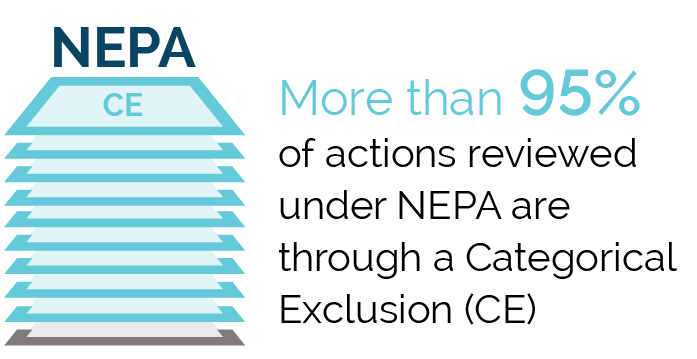
It’s no secret that it is difficult to build infrastructure in America. Anecdotes of decades-long planning and permitting for highways, pipelines, mines, transmission lines, and various other “big” things are everywhere. As we acknowledge this challenge, there are numerous theories about how to solve it—generally lumped together under the label “permitting reform.”
Congress has a role to play, to be sure, but despite recent bipartisan talks on the topic, a legislative solution is far from certain. The president’s decision to rescind the Council on Environmental Quality’s (CEQ’s) implementing regulations presents a more immediate opportunity.
In his “Unleashing American Energy” Executive Order, the President directed the CEQ to rescind the National Environmental Policy Act (NEPA) implementing regulations that have provided federal agencies with consistency in applying NEPA across government for nearly 50 years.[1] Agencies are directed to update their own NEPA implementing procedures, consistent with the statute and recent CEQ guidance.[2] CEQ remains responsible for reviewing and approving agency NEPA procedures, and presumably will continue to ensure consistency across agencies to avoid conflicting policy or guidance. But beyond the concern about consistency, the revocation of CEQ’s NEPA implementing regulations has opened a window to reimagine how we “do” NEPA.
An ideological movement is growing focused on the theory of “abundance.”[3],[4],[5] In the simplest terms, the abundance theory suggests that our multiple layers of policies and regulations created in good faith to guard against unchecked growth and development, and associated environmental impacts, have gone too far and now obstruct the development of clean energy, affordable housing, and other things seen as essential to sustainable progress and growth. The rules governing housing and infrastructure development are so stringent they create a “scarcity” of those projects. If we are to effectively combat climate change or provide sufficient housing to drive costs closer to affordability, then these types of projects cannot be scarce—rather they should be abundant and our rules around their development should encourage them rather than stymie them.
This “abundance” concept spurred my thinking around best next steps for NEPA. This is the time to consider how NEPA implementation can be done in a way that stays true to its intent (disclose environmental effects of federal actions) while enabling rather obstructing development (which its opponents often claim).
I believe that we are at an inflection point where we can modernize our thinking about the federal role in evaluating the environmental effects of our investments and do so in a way that balances the need to “look before we leap” with the recognition that we must, in fact, leap.
Now is the time to institute some much-needed, common-sense reform into NEPA and embed it into the agency procedures that are being updated. We should start with the low-hanging fruit and improve the way to do the simplest NEPA reviews first. Recognizing that the devil is in the details, the ideas that follow seek to start the conversation about rethinking how we approach NEPA and permitting. As with any permitting solution, there is no one-size-fits-all answer, but if we don’t start questioning our assumptions and take advantage of the unique opportunity before us, we may continue with a version of the status quo, perpetuating the challenges that NEPA implementation can present.
Categorical Exclusions – Covering 95% or more of actions reviewed under NEPA
Categorical Exclusions (CEs) are the simplest and most straightforward “approval” under NEPA. These are listed actions or categories of actions that experience has shown do not typically result in significant environmental effects, and thus do not require further detailed analysis. Congress amended NEPA in the Fiscal Responsibility Act to allow agencies to share CEs so that, in an overly simplified example, the Department of Energy (DOE) could adopt a Department of Transportation CE to satisfy NEPA for a roadway project on a DOE facility. This interoperability of CEs is a game-changer, as 95% or more of actions reviewed under NEPA are done through a CE. But that doesn’t mean that CEs are automatic. There is no current consistent way across government to track how much time it takes to complete a CE, and there is broad inconsistency across agencies on how much documentation is necessary to prove that a CE is appropriate for the project.

That’s a problem. Consider that if there are environmental effects—of any sort—there is likely to be a different, substantive, environmental law that regulates the impacts to that resource (think the Clean Water Act, Endangered Species Act, National Historic Preservation Act, etc.). With that in mind, why should CE documentation need to provide substantive discussion of resources that are otherwise regulated? Too often, we are burdened with robust resource surveys to prove that a project meets the conditions of a CE, and then revisit those efforts with the regulator to seek a permit.[6] CEs should require simple desktop surveys with a determination conditioned on permit approvals. For example, while robust biological surveys may be required for compliance with the Endangered Species Act, a desktop survey should be sufficient to determine whether there is potential for environmental effects that would negate the CE’s applicability, and if that potential exists then the agency would move to an Environmental Assessment (EA). With 95% of federal actions covered by CEs and nearly 100,000 CEs completed each year, the benefits of even modest time savings for these routine actions could be substantial, without sacrificing environmental rigor.
For the desktop survey to satisfy initial screening for a CE, agencies must also establish common “unusual circumstances” or “extraordinary circumstances” that, when present, would potentially elevate the NEPA documentation required from a CE to an EA. With broader sharing of CEs across agencies, there needs to be greater standardization on what constitutes a sufficient trigger for additional analysis, possibly negating the use of the CE. With such an approach, there also must be a change in the way we think about NEPA documentation and move away from trying to force more projects into a CE that requires lengthy studies and documentation to prove that there are no effects. Instead, we should return to the true intent of a CE, applying them when it is clear that no impacts will result from the action. If there’s a question, we shouldn’t be so afraid of conducting an EA. When done correctly, an EA should take no longer than it currently takes an agency to complete a fully documented CE. If you take a step back and think about it, a documented CE is, for all intents and purposes, what an EA was originally envisioned to be.
In addition to improving the way that we document and approve CEs, agencies should establish common definitions and terms to enable effective tracking of CEs—how many CEs are approved, for which types of projects, and how long it takes to complete the CE determination. There is currently no way to answer specific questions about the federal government’s use of CEs, and as we move toward relying on CEs for even more projects, we must do a better job of tracking and reporting on their use to understand trends and inform future reforms.
The elusive goal of balancing environmental protection with responsible development remains, but with targeted change and a rebalancing of our expectations around the simplest form of NEPA review, we may be able to make real progress.
Environmental Assessments
An agency prepares an EA when impacts are unknown and a CE may not apply, but it’s not readily evident that the severity of the environmental effects would trigger the more robust Environmental Impact Statement (EIS). As with the CE approach, the documentation necessary for an EA should focus on the resources and effects that are not otherwise regulated under existing environmental laws. Further, if there is no effect on a particular resource, agencies should be encouraged to acknowledge that and move on, while simultaneously discouraged from expending limited resources to prove that negative. I’d also argue that EAs should be limited to the proposed action; alternatives analysis in an EA should similarly be discouraged.
An EA is, by its nature, a means to determine whether there are significant environmental effects from an action. Before the Fiscal Responsibility Act authorized the sharing of CEs, an EA might have been undertaken because the action was unique to an agency and there was no applicable CE. That trigger is much less likely now, and as a result EAs should be limited to instances where the extent of potential impacts is truly unknown and additional analysis is necessary to determine the appropriate path forward under NEPA (e.g., whether a Finding of No Significant Impact is appropriate or an EIS is necessary). EAs should not be planning documents—the work of evaluating alternatives to determine which best meets the need of the project proponent while reducing environmental effects should be done prior to initiating NEPA, allowing the EA to focus on the potential effects of the proposed project.
Technology
Agency implementing procedures across government should acknowledge and encourage the use of cutting-edge technologies to support planning and environmental review and permitting. As much as possible, agencies should explicitly encourage the use of geographical information systems to identify resource areas of concern. Procedures should encourage sharing information with partner agencies and recognize that, for the vast majority of NEPA decisions, a desktop survey is sufficient to confirm the applicability of a Categorical Exclusion. Agencies should also encourage the appropriate use of artificial intelligence to help with environmental screening and standardized documentation. If we are able to rethink and right-size the use of CEs to move projects forward, technology will be an indispensable partner in justifying the decision.
How Does this Lead to Abundance?
Focusing in the immediate term on improving the way we do the vast majority of NEPA through administrative remedies is one strategy to help us get out of our own way and enable critical infrastructure to move forward responsibly. I believe wholeheartedly that industry’s incentives when planning and siting projects are generally aligned with the perspectives of regulators, as regulatory risk introduces financial risk and certainty is extremely valuable. If we improve the way that we do NEPA for more routine actions, and that efficiency can incentivize the planning and design of projects that meet CE standards with increased certainty in timeliness of approvals, perhaps we move more projects forward faster. For those few projects that don’t meet the conditions for a CE but are unlikely to result in significant adverse environmental effects, let’s focus our efforts on what we don’t know so that we can quickly determine how best to proceed. Paralysis by analysis is real and should be avoided when additional analysis is unlikely to produce information that will affect the project definition.
Conclusion
The reforms suggested here focus on nearly 99% of NEPA actions and could produce measurable improvements in the process. But the 1% or so that remain are the Environmental Impact Statements that are usually the focus of permitting or NEPA reform discussions. While I believe we can do NEPA better on the most complex and impactful projects requiring an EIS, I am less confident that those improvements can be made through updates to agency procedures. For effective reform to the EIS process, Congress will likely need to intervene.
Similarly, the reforms suggested here are, by design, broad strokes to start the conversation. Each individual project will have unique context that may challenge the use of a desktop survey, for example. And there is no substitute for meaningful field work to understand the localized impacts of proposed projects. But what if we focus that effort on the actions that are truly impactful and return our approach to routine federal actions as being just that—routine?
Federal environmental policy is not the only hurdle to clear for projects to advance. State and local policies play an equally important role in slowing or killing projects, so we cannot and should not lay the blame squarely on NEPA. But, with some common-sense reforms to the way we do our routine actions, we may take the “NEPA is the problem” talking point off the table, allowing us to focus finite human capital and constrained project schedules on the resources and issues that truly matter. The elusive goal of balancing environmental protection with responsible development remains, but with targeted change and a rebalancing of our expectations around the simplest form of NEPA review, we may be able to make real progress.
[1] See https://www.federalregister.gov/d/2025-01956.
[2] See https://ceq.doe.gov/docs/ceq-regulations-and-guidance/CEQ-Memo-Implementation-of-NEPA-02.19.2025.pdf.
[3] See https://www.niskanencenter.org/the-rise-of-the-abundance-faction/.
[4] See https://www.nytimes.com/2025/02/27/opinion/government-great-progressive-abundance.html.
[5] See https://www.nytimes.com/2025/03/09/opinion/musk-trump-doge-abundance-agenda.html.
[6] This line of thinking is borrowed from James Connaughton’s “Approve, Build, and Comply (ABC)” model – see https://nautilusdt.com/news-updates/brownfields-the-next-frontier-for-data-centers-and-industrial-innovation/.








